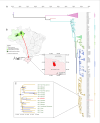Oropouche Virus Importation in Southern Brazil and Emerging Concern Calling for Enhanced Public Health Surveillance
- PMID: 40788114
- PMCID: PMC12338014
- DOI: 10.1002/jmv.70557
Oropouche Virus Importation in Southern Brazil and Emerging Concern Calling for Enhanced Public Health Surveillance
Abstract
Oropouche virus (OROV), an arthropod-borne virus transmitted by Culicoides paraensis, is an endemic arbovirus that historically circulates mostly in the Amazon basin. Between 2022 and 2024, it reemerged as a more widespread public health concern in South America. We conducted a pooled-sample molecular surveillance study to understand the prevalence of Oropouche fever in Brazil's southernmost state. Over 18 months, we analyzed 4060 samples to monitor the virus emergence in the Rio Grande do Sul state. We detected the first human case of OROV in the state, and our phylogenetic reconstruction indicated a travel-related introduction from the Amazon region into Rio Grande do Sul. Despite the absence of local transmission, the invasion of Culicoides paraensis and enzootic circulation of the OROV in Rio Grande do Sul highlight the risk of Oropouche fever outbreaks in the region. We demonstrated that pooled-sample surveillance effectively monitors virus introduction during periods of low endemic circulation, serving as an essential active surveillance tool for the timely detection of virus emergence and enhancing public health preparedness. The multiple introductions of distinct OROV lineages into southern Brazil underscore the importance of genomic surveillance and public health strategies to monitor and mitigate arbovirus spread in the region.
Keywords: Brazil; Oropouche; arbovirus; surveillance; virus emergence.
© 2025 The Author(s). Journal of Medical Virology published by Wiley Periodicals LLC.
Conflict of interest statement
The authors declare no conflicts of interest.
Figures


Similar articles
-
Assessing the vector competence of Italian Culex pipiens and Aedes albopictus mosquitoes for the re-emerging Oropouche virus.Parasit Vectors. 2025 Jul 8;18(1):268. doi: 10.1186/s13071-025-06912-x. Parasit Vectors. 2025. PMID: 40629438 Free PMC article.
-
Travel-associated international spread of Oropouche virus beyond the Amazon.J Travel Med. 2025 Mar 30;32(3):taaf018. doi: 10.1093/jtm/taaf018. J Travel Med. 2025. PMID: 40037296 Free PMC article.
-
Insights into the expansion of Oropouche virus in Brazil: epidemiological and environmental aspects.Exp Biol Med (Maywood). 2025 Jul 24;250:10647. doi: 10.3389/ebm.2025.10647. eCollection 2025. Exp Biol Med (Maywood). 2025. PMID: 40776978 Free PMC article. Review.
-
A Comprehensive Review of the Neglected and Emerging Oropouche Virus.Viruses. 2025 Mar 19;17(3):439. doi: 10.3390/v17030439. Viruses. 2025. PMID: 40143366 Free PMC article. Review.
-
Oropouche orthobunyavirus in Urban Mosquitoes: Vector Competence, Coinfection, and Immune System Activation in Aedes aegypti.Viruses. 2025 Mar 28;17(4):492. doi: 10.3390/v17040492. Viruses. 2025. PMID: 40284935 Free PMC article.
References
-
- Pinheiro F. P., Travassos da Rosa A. P. A., Travassos da Rosa J. F. S., et al., “Oropouche Virus. I. A Review of Clinical, Epidemiological, and Ecological Findings,” American Journal of Tropical Medicine and Hygiene 30 (1981): 149–160, https://pubmed.ncbi.nlm.nih.gov/6782898/. - PubMed
MeSH terms
Supplementary concepts
Grants and funding
LinkOut - more resources
Full Text Sources

